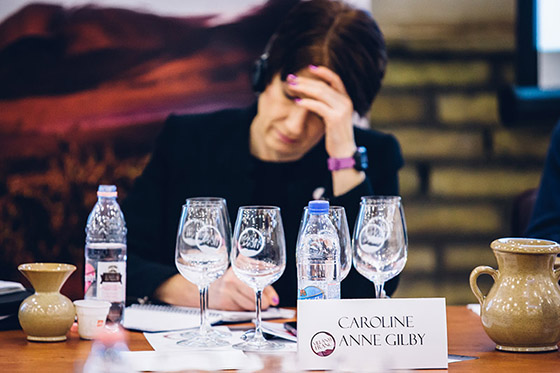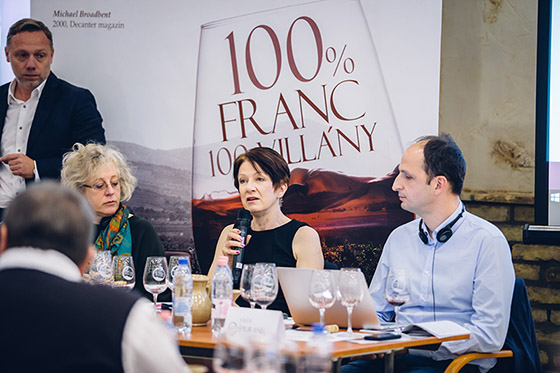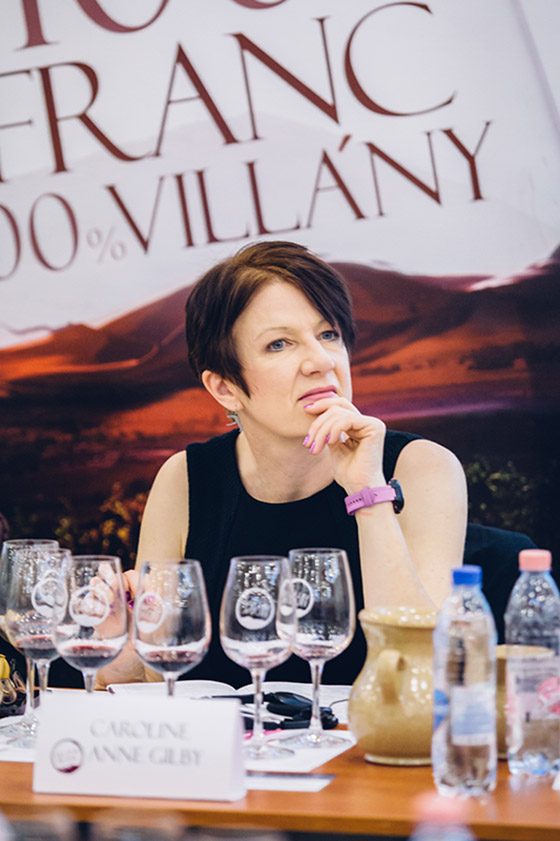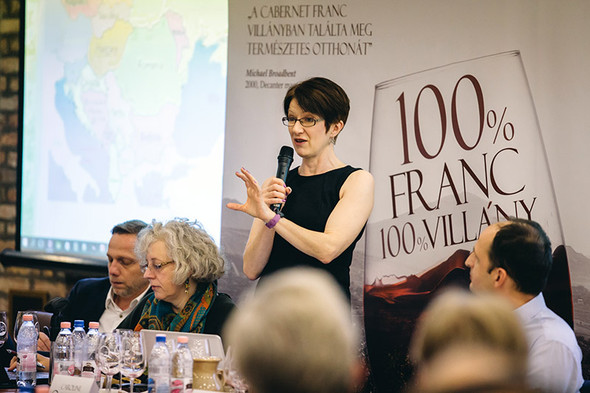Photos: Gadget Fotó
Caroline Gilby MW was in Villány together with Elizabeth Gaby MW for Franc&Franc. I asked her for some thoughts on Hungarian wine in general, including how the world views Hungarian wine.
You’re a specialist on Central and Eastern Europe? What made you go for this region?
Well, I started in the wine trade in 1988 working for an off-licence chain called Augustus Barnett. Of course, Eastern Europe at the end of the 1980s was actually huge in the UK, particularly Bulgaria, and being the junior trainee buyer, Eastern Europe not being very glamorous, they gave that to me as my first buying responsibility. At the time, it certainly wasn’t very glamorous, but with hindsight, was a fantastic opportunity to see the start of the new era, as I was visiting wineries still very much on the old collectivised model, so I could see where the industry has come from to where it is today. People only starting to write about Eastern Europe now have only seen the new stuff; they don’t see where it came from.
When did your involvement with Hungary start?
Hungary must have been not long after that, at the beginning of the 1990s. I was looking for a white partner to what Bulgaria was doing and had the opportunity to come and see what was happening in Mátra at that point. There were some very good value white wines coming from there. My first wine was a Pinot Blanc and then I went on to add Pinot Gris, Chardonnay and various other things, including a nice, dry Muscat.

Yes, the Mátra produces some very nice aromatic whites, although many of the younger winemakers are seeking to change that image.
It does worry me a bit that the Mátra all think they want to make serious reds. The world’s got plenty of serious reds. What people really want is refreshing whites and gentle reds that they can drink anytime.
When you first came to the region, you said there were collectives and so on. How have you seen things change since then?
It’s been a complete revolution. In Hungary at that point I was going and visiting wineries in the middle of nowhere; vast, echoing, empty wineries with railway sidings in them that didn’t know what to do with themselves because they’d lost all their easy Soviet markets, admittedly a few years before that, and hadn’t really worked out what the West needed at that point.
When do you think the biggest changes took place?
I think for me, joining the EU and the impetus that brought, that was a big spur forward. Of course, it depends a bit on what region you’re looking at. Certainly, the mid to late-nineties saw the huge development in quality wines down in Villány and so on. If you look at Tokaj, probably ’99 with the development of the late harvest wine, 2003 when the dry wines started seriously and then probably 2010 was the era of sparkling wine. The point being, if I’d chosen to write about France or Italy, then I might have seen a tiny bit of evolution, but here I’ve seen a complete revolution and it still keeps coming.
Most of the changes are positive, we see development, the emergence of smaller wineries, investment in technology and so on, but has there been anything you would consider to be negative?
There is a certain reluctance to work together and intellectually I get it: if you’ve been forcibly collectivised in the past, then you want to plough your own furrow and develop your individuality. Unfortunately, Hungary is a small country in a big world of wine, and if it wants its wines on the world market, and that’s another question, then it has to work together. The producers here have to understand that they need the big guys, the likes of Törley and Hilltop, so long as they’re doing a good, fair job, that is, to create the category, because every time someone picks up a bottle of Pinot Grigio and says, ‘That was nice. Oh, it came from Hungary!’, it’s creating awareness of Hungary as a wine country. And you also need the small guys, who create the interesting stuff and push things forward in terms of quality as well. Getting both sides of that to talk and work together in Hungary is a nightmare. There’s a kind of snobbery about it.

How do people outside Hungary see Hungarian wine? Elizabeth said yesterday that most people don’t even know Hungary produces wine.
Well, I think that’s true. Lots of people know about Budapest and go there, or have ambitions to, but that doesn’t extend to the rest of the country, which is a shame, you know. You have pretty positive experiences in Budapest; the food, the wine, the place, which you could use as a hook to get people into the wider Hungary. I don’t know how to do that as I’m not a marketer, but it would be a good way forward if someone could work out how to do it. It’s important as most people don’t think of Hungary as a wine-producing country. But I think the likes of Erhard [Heumann] at least get the message out there subtly that this country is producing wines that people like drinking.
I live in Hungary, so am probably rather too subjective, but how do you see the potential here? And what could they do to achieve it? I suppose cooperating a bit better.
And cooperating in not just the marketing, it comes back to the winemaking and viticulture as well. I mean it is changing, you know, the first generation were very much individuals, but the younger generation are much more likely to talk to each other, taste each other’s wines, swap ideas and travel together. They can’t just sit back and say ‘we make the best wines in Hungary’; they need to know what everyone else in the world is doing, because everyone else is not stopping.
What do you think should be the flagship regions of Hungary if it extends itself further onto the world stage?
Certainly, the ones I tend to talk about. Obviously Tokaj comes first, but I also talk a lot about Eger and Villány. It’s a good story, there are some good wines and interesting personalities.
You’ve obviously had a lot of experience with Hungary and interesting characters, what’s been the most interesting or strangest thing that’s happened to you in your travel or experiences of Hungarian wine?
There was one winemaker who didn’t speak to me for at least five years after I was trying to be constructive about 17.5% alcohol not necessarily being the best way forward for the British market.
Which was the point you were trying to make in Villány – the issue with the high alcohol and oaking.
I mean there is a point where producers need to decide whether they want to export or are they happy selling to the domestic market and catering to domestic tastes, which is a perfectly valid choice.
We were talking about thislast time as well regarding Villány. Maybe two styles, catering to that market as there is clearly still a market here and certain winemakers certainly want to continue in that style.
Yes, and that’s absolutely fine. But you know, some people want to export for the prestige, although in many cases, it doesn’t make commercial sense as they’d have to cut their prices to export. There’s a cost to exporting as you’ve got to travel and go to customers and so on, and it demands a lot of marketing support to make sense. A bit more strategic thinking about whether people really want to export would be quite useful.

You’re down in Villány for these Cabernet Franc days. What did you think of the event and wines and how do you see their future possibilities?
I think this whole thing’s been great. Actually getting all these winemakers together in a room, talking, listening and exchanging ideas has been wonderful. Getting them to taste wines from outside the region, and hopefully stimulating thoughts on whether there are good, or bad, ideas to learn from. The Italian section was fascinating as they’re making their wines quite cheaply and yet selling them for quite high prices, as they’re cropping at high yields, and not using oak. So, I would hope some people have gone away thinking there might be another route to success here to consider, even if it’s maybe not what we want to do, we should think about it.
Any final words of advice regarding Villány Franc?
Personally, I do think Cabernet Franc has real potential here, but I think they’re wrong to drop the Cabernet from the message for international marketing. Villány Franc is fine in Hungary, but outside, you need to mention the Cabernet. It’s too much of a step to go from a country nobody really knows about to a rather forgotten grape and to a region that definitely nobody’s heard of and if you’re English, can’t even pronounce. It’s got potential for fine elegant wines in this climate and keeps its acidity, unlike Merlot which can get overripe. Some people over-extract for my taste, but there are people who like those wines, so that’s absolutely fine. Some people do it very well. Although it’s not a style of wine I’d choose to drink myself, I can admire what they’re doing for their customers.
One final thing, I was just wondering whether you’d looked at WineSofa or read any of our articles.
I have, yes.
What are your thoughts on this, the idea of trying to get Central Europeans to cooperate?
I would love it. It’s something I’ve talked about for years. You know, I’m kind of at the centre of all these Central and Eastern European countries. But if you can’t get them to cooperate within a wine region, getting them to cooperate across half a continent would be difficult. I’d love it to happen more often. I’ve been talking about it at various times, looking whether we could do something.
Well, we’re trying. Hopefully something will come of it!






